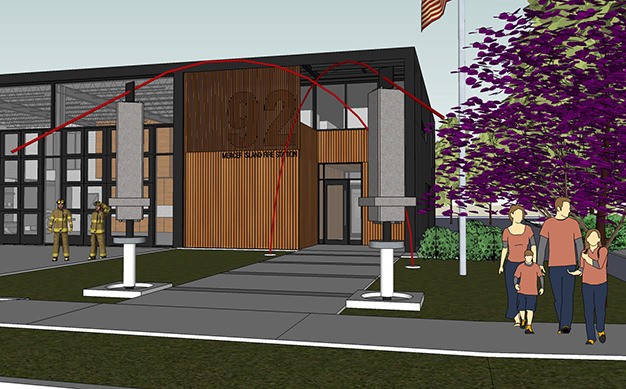In June, the City of Mercer Island received artifacts from the World Trade Center that will eventually be installed in front of the newly remodeled Fire Station 92. The artifacts — a part of the floor and ceiling sections of one tower garage and a pillar bisecting the two — will be cut to size and installed as a gateway to the station. The Mercer Island Fire Department hopes the piece will encourage dialogue about September 11, 2001 and the events that followed.
The Reporter talked with artist John Sisko, who is working alongside architect Jim Brown, to finalize the piece. This interview has been edited for length and coherence.
Q: You attended the dedication ceremony for the 9/11 beams back in June. What was that like?
A. It was really exciting because it was just about one year from when we’d first secured the piece. There had been a lot of bureaucracy…We had to do all sorts of things, insurance forms and contracts.
I was just happy to see the picture of the truck in Pennsylvania [after the artifacts left New York], loaded up and ready to go. We had a patient driver, Tommy, and we started to make arrangements [for the artifacts] to stop at fire houses all over the country. It became this big event. We were in little newspaper articles all over the country. I met the truck in Coeur D’alene, Idaho. Then we crossed the border into Washington and we wanted to accompany it across the state.
[In Spokane] we had three state patrol lead us through the town, blocking intersections. By the time we got to Mercer Island, we had 15 vehicles [behind us], it was crazy. That was a work of art in itself.
Q: How is the piece coming along?
A: It’s coming along very well actually. The fire department is [helping us] bring the pieces down to [size]. We’re working on getting construction permitting. It’s just like you’d do for any building actually.
Q: How did you arrive at your plan for the final design?
A: One thing that we were asked to do was to interface with the architect, the construction teams, the fire department and the people in the community…We asked [to talk] to the guys [at the station].
The idea of this being a memorial doesn’t sit well with any of us. But we do want it to frame the discussion. That’s why the [artifacts] will act like a gateway, like a frame for how we look at [September 11]…It’s about that moment that changed our point of view. And certainly it’s not supposed to be a memorial. We don’t feel like it’s our place.
Q. What do you make of some of the controversy surrounding tribute pieces and September 11 memorials? One bronze sculpture made from World Trade Center artifacts has struggled to find a home after residents in Kirkland and Olympia argued against its installation because there was no local connection.
A: It’s all about how you…connect with the piece. That’s really the beautiful thing about what we’re doing. When we brought it across the state and the country, we had so much enthusiasm. [These artifacts] connect people.
Q: What role does research play in the your creative process?
A: The research is sometimes not in advance but very much ongoing as the project moves on. One of the things we wanted to do was to interface [the installation] with the park across the street. So we took a day and hiked through the park to see the wetlands and other areas.
[And when we talked with firefighters] we realized it’s definitely a real brotherhood, or even a cult, in terms of how they regard each other.
As an artist, you’re tasked with making this image that encapsulates all of that. That’s a real challenge. You have a lot of people to deal with: the city, the fire department, firemen and fire women and the community. There are also other architects, the building codes and departments.
[The art installation] will serve as a gateway and create a frame. When [people] pass through this, [we hope] they’ll be really aware of the relationship between the fire service and the community. I’m really proud of what we’ve come up with.
Installation of the memorial is planned for later this year.



